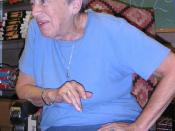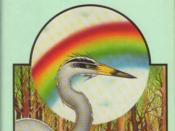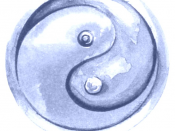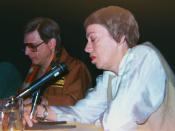Although Ursula K. Le Guin's primary subject in The Left Hand of Darkness may not be feminism, one of the book's main interests appears to be the question of gender. Le Guin holds a thought experiment to see what happens when society does not have a male or female. In chapter seven of the novel the main character, Genly Ai, states, "Room is made for sex, plenty of room; but a room, as it were, apart"(Le Guin 93). Because sex is not a constant in these people's lives, there is a psychological impact. There are no sexual expectations they have to live up to: men do not have to try to be masculine; women do not have to try to be feminine. A large portion of deriving one's status in society can come from filling sexual roles: men try to be providers, be strong; women trying to be good care givers, nurturers.
From one point of view, "it is a novel about women, women's lives, and the meaning of love and sexuality in women's lives. From another, it is about two characters who both appear to be males and who come to love one another, sexually as well as fraternally"(Frazer 222). The use of androgyny, which is not used to satisfy the author or many of her readers, virtually removes the consideration of gender from the text.
As Le Guin alters the idea of a fixed gender, feminists criticize her novel on the use of the generic "he" and on the choice of man, Genly, as the interpreter and main character of Gethan. Being a feminist utopian novel, many feminists claim that there are in fact no women roles being played. "If 'women' are constructed and defined by their unique ability to bear live children, such beings are absent from Le Guin's novel"(Rudy 32). This critique tells us how there is no separate group of individuals marked by their ability to produce children; if all people can serve that function, all people are both men and women. According to many feminist critiques, an individual must have embodied a set of gender characteristics otherwise, an individual who is both male and female is, in effect, neither. With the principles of feminism and the understanding of womanhood, a conflict stands in the way that the world is presented in this novel. That is, the world "where female nature as well as male nature are both a part of every person, and where sexual identities operate only inside certain contexts"(Rudy 32).
In contrast to a feminist's point of view, gender theorists as well as proponents of gender reconstruction believe that gender should be thought of as flexible and dependent on context. The distinctions that exist between men and women could be negotiated differently when looking at social events and strategies verses scientific tests. Gender is a matter of social construction especially when we reason the idea that there are only two gender types. Our matter of performing whether one acts like a female or a male is what codes us to uncertainty. Our gender is established on the basis of a social grid with respect to a child behaving as a boy or girl. As a part of culture, it is something we 'do', not something we 'are'. Relating to this cultural perspective, Genly demonstrates throughout the novel how he "struggles unsuccessfully to see the Gethanians as androgynous while he is, in turn, perceived by them as a 'pervert' because he is always genitally masculine"(Frazer 223). The lines should not be between men and women because you are not born with gender; rather, it should be between biological facts and performances.
Le Guin writes in a book review that she escaped maledom by inventing the androgynes (Pennington 351). Le Guin's claim that she "escaped maledom" remains problematic amongst many female critiques. Her pride on her controversy made the critiques believe that she relies too much on traditional narratives rather than the possibility of creating a new language to replace English sexist pronouns. In contrast to these feminist critiques one may analyze from a male viewpoint the way a man is satisfied by the book by allowing them to imagine a trip to androgyny and back. Where as, women who are more daring and want to go further, explore androgyny from a women's point of view as well as a man's (Pennington 356). In fact, Le Guin does so as the author of The Left Hand of Darkness. In chapter seven, The Question of Sex, the field notes of a woman investigator admits, "It seems likely that they were an experiment. The thought is unpleasant" (Le Guin 89). Through this quote one may notice that Gethanians must not "cast him in the role of Man or Woman" because their "entire pattern of socio-sexual interaction is nonexistent." The investigator states how they do not see one another as either men or women (Le Guin 94).
From a feminist's point of view, they may deduce that their ambi-sexuality has little or no adaptive value by trying to justify their differences rather than trying to understand their way of acting and their values. Preconceiving these ideas will lead them to conflicts and problems in reality. Instead, they should try to understand the different perspectives to understand the different culture and environment of a dominant world rather than just the sex of a human being.
In The Left Hand of Darkness there are only two characters with which readers can identify. Genly Ai is a conventional male with whom masculine readers can identify by his social roles. He is also recovering suppressed female qualities throughout the novel. In support to Le Guin's element of writing of no gender role, one may find that the purpose of Le Guin's plan for feminine readers is to have them appreciate Estraven, the main Gethanian character, as "manwoman" rather than man, but this identification has been obstructed by his not being given "any role which we automatically perceive as 'female'"(Barrow 85). As for a feminist, they may classify a male developing themselves through separation and ideals of perfection, while female develop through connection and activities of care. Barrow states that the role of Genly is not to reinforce stereotypical male attitude but to expose them (85). In chapter 19 of the novel, Genly is in one of his journeys with Estraven where he draws out the yin/yang symbols of Taoism. Simply described, Taoism is a belief that derives from tension between dualities. Genly tells Estraven, "It is yin and yang. Light is the left hand of darkness . . . how did it go? Light, dark. Fear, courage. Cold, warmth. Female, male. It is yourself, Therem. Both and one. A shadow on snow" (Le Guin 267). Thus, Genly would prefer to see Estraven as yang and not yin after learning of Estraven's feminine qualities. Now Le Guin has recognized Taoism's dualistic feminine yin and masculine yang (Barrow 85).
"In the world of Gethan, no one group of people is biologically attached to the home of to childbirth or child care. One's genitals do not dominate one's role in reproduction or in culture"(Rudy 34). In today's world, the roles of men and women are being crossed. For the most part, we have begun to accept the fact that gender does not dictate who we "are" and what we "do" and with this our life relates to the one Le Guin describes throughout the novel. Le Guin is simply describing the outer limits of some existing changes to fins out what happens when you remove sexual roles, and to an extent sex, from society. Le Guin's novel reminds us that rather than casting into tow categories "men" and "women", we could eliminate the possibility of creating a world like Gethan. Giving men greater liberty with this book allows the reader to be completely immersed in a foreign world, to know what it is like to be alienated.
Works CitedBarrow, Craig, and Diana Barrow. "The Left Hand of Darkness: Feminism for Men." Mosaic 20.1 (1987): 83-96.
Frazer, Patricia, and Diana Veith. "Again, The Left Hand of Darkness: Androgyny or Homophobia?" Erotic Universe. Sexuality and Fantastic Literature. Ed. Donald Palumbo. Westport, CT: Greenwood, 1986. 221-232.
Le Guin, Ursula K. The Left Hand of Darkness. Trade ed. New York: ACE Book, 2000.
Pennington, John. "Exorcising Gender: Resisting Readers in Ursula K. Le Guin's Left Hand of Darkness." Extrapolation: A Journal of Science Fiction and Fantasy 41.4 (2000): 351-358.
Rudy, Kathy. "Ethics, Reproduction, Utopia: Gender and Childbearing in Women on the Edge of Time and The Left Hand of Darkness." NWSA Journal 9.1 (1997): 22-38.





